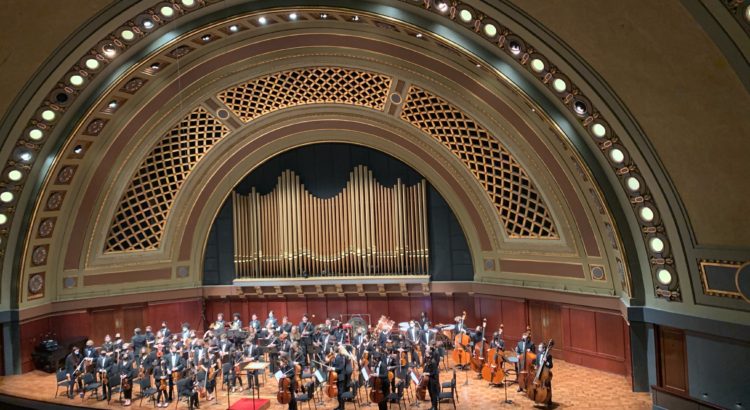On October 14th, I had the pleasure of attending the University Philharmonic Orchestra’s fall concert at Hill Auditorium. As a freshman, I was especially excited to see this instrumental group as they feature an all-freshman string section. The University Philharmonic Orchestra program, in particular, is designed to allow student musicians to sharpen their performance skills while playing world-renowned works in a large ensemble setting.
Boasting four diverse musical selections and a special organ feature by world-renowned organist James Kibbie, the concert was truly entertaining. The excitement of the students in the orchestra was palpable — adding to my enjoyment of the evening. Further, Hill’s exquisite interior added frill to the already lively atmosphere. I would, however, have wished that there were more even people in the audience, especially given that Hill is an exceptionally large venue.
The orchestra opened the concert on a bold and majestic note with “As Dancing is to Architecture” (1996) by Christopher Theofanidis. This piece highlighted the orchestra’s ability to infuse harrowing and meaningful volume dynamics in a piece. The sharp shifts in volume kept me deeply engaged. “As Dancing is to Architecture” was a thrilling piece played beautifully by the group.
The second composition, “Czech Suite, op. 39,” (1879) by Antonín Dvořák was perhaps the most well-known piece played during the concert. Much longer than the previous selection, this composition showcased the group’s stamina and concentration. I enjoyed each of the five movements of the suite and further appreciated the large stylistic variation between them. In particular, I especially loved the dynamic second movement “Polka: Allegretto giousto.” This movement combines smooth and traditional polka cadences with stark melodic shifts. Moreover, the composition begins somber but ends in an upbeat manner — an unexpected twist. Additionally, the fourth movement “Romance: Andante con moto” displayed the prowess of the flute section as their beautiful melodies were fundamental to the movement.
Following the Dvořák suite, was Johannes Brahms’ “Variations on a Theme of Haydn, op 56a (1873). Despite the title of this piece, this composition does not borrow themes from famed composer Joseph Haydn. Instead, it borrows from a lesser-known composer whose piece, “Chorale St. Antoni” was incorrectly accredited to Haydn. This intense piece was a testament to the orchestras’ musicality as it was infused with deep, palpable emotion. It was performed beautifully.
The final piece “Toccata Festiva” (1960) by Samuel Barber, which featured organist James Kibbie, was my favorite. In order to perform this, chairs were rearranged so that an organ could be raised from beneath the stage. Watching this aspect of the setup process only made me more eager to hear the organ. Luckily, Kibbie did not disappoint. Somber yet majestic, I was captivated for the entire duration of the piece. It was truly incredible to watch Kibbie traverse both the foot pedals and the keyboards of the organ. Everyone around me, myself included, stared at him and leaned forward in their seats — desperate to get a closer view. I have never been more in awe during a performance than while watching Kibbie’s organ solo that occurs about halfway into the piece. The ominous and rich low organ notes reverberated throughout the entire room. I was further amazed that Kibbie seemingly performed the quick and difficult solo section with ease and grace. It was an amazing performance by Kibbie and the rest of the orchestra.
I would recommend that anyone who has the opportunity to see the University Philharmonic Orchestra perform most definitely should.


